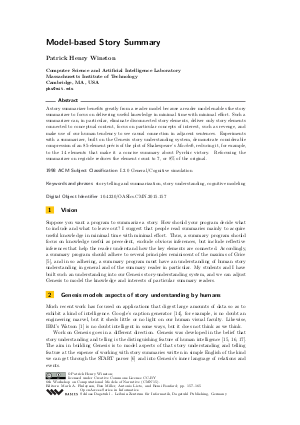Model-based Story Summary
Author Patrick Henry Winston
-
Part of:
Volume:
6th Workshop on Computational Models of Narrative (CMN 2015)
Part of: Series: Open Access Series in Informatics (OASIcs) - License:
 Creative Commons Attribution 3.0 Unported license
Creative Commons Attribution 3.0 Unported license
- Publication Date: 2015-08-14
File

PDF
OASIcs.CMN.2015.157.pdf
- Filesize: 415 kB
- 9 pages
Document Identifiers
Subject Classification
Keywords
- story telling and summarization
- story understanding
- cognitive modeling
Metrics
- Access Statistics
-
Total Accesses (updated on a weekly basis)
0PDF Downloads0Metadata Views
Abstract
A story summarizer benefits greatly from a reader model because a reader model enables the story summarizer to focus on delivering useful knowledge in minimal time with minimal effort. Such a summarizer can, in particular, eliminate disconnected story elements, deliver only story elements connected to conceptual content, focus on particular concepts of interest, such as revenge, and make use of our human tendency to see causal connection in adjacent sentences. Experiments with a summarizer, built on the Genesis story understanding system, demonstrate considerable compression of an 85-element précis of the plot of Shakespeare’s Macbeth, reducing it, for example, to the 14 elements that make it a concise summary about Pyrrhic victory. Refocusing the summarizer on regicide reduces the element count to 7, or 8% of the original.
Cite As Get BibTex
Patrick Henry Winston. Model-based Story Summary. In 6th Workshop on Computational Models of Narrative (CMN 2015). Open Access Series in Informatics (OASIcs), Volume 45, pp. 157-165, Schloss Dagstuhl – Leibniz-Zentrum für Informatik (2015)
https://doi.org/10.4230/OASIcs.CMN.2015.157
BibTex
@InProceedings{winston:OASIcs.CMN.2015.157,
author = {Winston, Patrick Henry},
title = {{Model-based Story Summary}},
booktitle = {6th Workshop on Computational Models of Narrative (CMN 2015)},
pages = {157--165},
series = {Open Access Series in Informatics (OASIcs)},
ISBN = {978-3-939897-93-4},
ISSN = {2190-6807},
year = {2015},
volume = {45},
editor = {Finlayson, Mark A. and Miller, Ben and Lieto, Antonio and Ronfard, Remi},
publisher = {Schloss Dagstuhl -- Leibniz-Zentrum f{\"u}r Informatik},
address = {Dagstuhl, Germany},
URL = {https://drops.dagstuhl.de/entities/document/10.4230/OASIcs.CMN.2015.157},
URN = {urn:nbn:de:0030-drops-52900},
doi = {10.4230/OASIcs.CMN.2015.157},
annote = {Keywords: story telling and summarization, story understanding, cognitive modeling}
}
Author Details
References
-
David Ferrucci, Eric Brown, Jennifer Chu-Carroll, James Fan, David Gondek, Aditya Kalyanpur, Adam Lally, J. William Murdock, Eric Nyberg, John Prager, Nico Schlaefer, and Chris Welty. The AI behind watson - the technical article. AI Magazine, 2010.

-
Mark A. Finlayson. Learning Narrative Structure from Annotated Folktales. PhD thesis, Electrical Engineering and Computer Science Department, MIT, Cambridge, MA, 2012.

-
Mark A. Finlayson and Patrick Henry Winston. Intermediate features and informational-level constraint on analogical retrieval. In Proceedings of the 27th Annual Meeting of the Cognitive Science Society, pages 666-671, 2005.

-
Dedre Gentner and Arthur B Markman. Structure mapping in analogy and similarity. American Psychologist, 52(1):45-56, 1997.

-
H. Paul Grice. Studies in the Way of Words. Harvard University Press, Cambridge, MA, 1989.

-
Boris Katz, Gary Borchardt, and Sue Felshin. Syntactic and semantic decomposition strategies for question answering from multiple resources. In Proceedings of the AAAI 2005 Workshop on Inference for Textual Question Answering, 2005.

-
Caryn Krakauer and Patrick Henry Winston. Story retrieval and comparison using concept patterns. In Mark Alan Finlayson, Pablo Gervas, Deniz Yuret, and Floris Bex, editors, Proceedings of the 3rd Workshop on Computational Models of Narrative (CMN'12), volume 3, pages 119-124. European Language Resources Association (ELRA), 2012.

-
Wendy Lehnert. Plot units and narrative summarization. Cognitive Science, 5(4):293-331, 1981.

-
Roger C. Schank. Conceptual dependency: A theory of natural language understanding. Cognitive Psychology, 3(4):552-631, 1972.

-
Roger C. Schank and Robert P. Abelson. Scripts, Plans, Goals, and Understanding: An Inquiry into Human Knowledge Structures. Lawrence Erlbaum Associates, Mahwah, NJ, 1977.

-
Roger C. Schank and Christopher K. Riesbeck. Inside Computer Understanding: Five Programs Plus Miniatures. Lawrence Erlbaum Associates, Mahwah, NJ, 1981.

-
Ian Tattersall. Becoming Human. Harcourt, Orlando, FL, 1998.

-
Ian Tattersall. Human evolution and cognition. Theory in Biosciences, 123(4):371-379, 2010.

-
Oriol Vinyals, Alexander Toshev, Samy Bengio, and Dumitru Erhan. Show and tell: A neural image caption generator. Cornell University Library digital repository, arXiv:1411.4555 [cs.CV], 2014.

-
Patrick Henry Winston. The strong story hypothesis and the directed perception hypothesis. In Pat Langley, editor, Technical Report FS-11-01, Papers from the AAAI Fall Symposium, pages 345-352, Menlo Park, CA, 2011. AAAI Press.

-
Patrick Henry Winston. The next 50 years: a personal view. Biologically Inspired Cognitive Architectures, 1:92-99, 2012.

-
Patrick Henry Winston. The right way. Advances in Cognitive Systems, 1:23-36, 2012.

